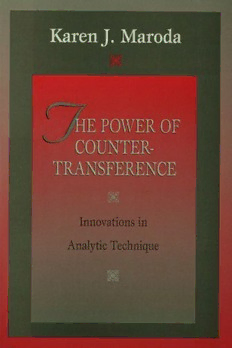
The Power of Countertransference: Innovations in Analytic Technique PDF
Preview The Power of Countertransference: Innovations in Analytic Technique
The Power of Countertransference Copyrighted Material Copyrighted Material The Power of Countertransference Innovations in Analytic Technique Second Edition, Revised and Enlarged Karen J. Maroda ~ THE ANALYTIC PRESS 2004 Hillsdale, NJ london Copyrighted Material © 2004 by The Analytic Press, Inc., Publishers All rights reserved. No part of this book may be reproduced in any form: by photostat, microform, retrieval system, or any other means, without the prior written permission of the publisher. Published by The Analytic Press, Inc. 101 West Street, Hillsdale, NJ 07642 www.analyticpress.com Library of Congress Cataloguing-in-Publication Data Maroda, Karen J. The power of countertransference : innovations in analytic technique I Karen J. Maroda. - 2"d ed., rev. & enl. p. cm. Includes bibliographical references and index. ISBN 0-88163-414-X (alk. Paper) I. Countertransference (Psychology) 2. Psychoanalysis. I. Title RC489.C68M37 2004 616.89' 17--dc21 2004046156 Library of Congress Control Number: 200410340 I Printed in the United States of America 10987654 Copyrighted Material Contents Acknowledgments vii Foreword-Lewis Aron IX Introduction Chapter 1 The Myth of Authority: On Building a Working Relationship 6 Chapter 2 Motivations for Treatment: The Pursuit of Transformation 33 Chapter 3 The Unfolding of the Transference and Counter transference: The Drama Re-Enacted 66 Chapter 4 The "Real" Relationship Versus the Transference and the Countertransference: The Impossible Distinction 97 Chapter 5 Countertransference Techniques: Constructing the Interpersonal Analysis 110 Chapter 6 Countertransference Issues at Termination 157 Conclusion 174 References 176 Arterword 181 Index 198 Copyrighted Material To EJH Copyrighted Material Acknowledgments I have always believed that any significant accomplishment by any individual was made possible by the avid support of one, or many, friends, family members or colleagues. Unquestionably this book would not exist without the contributions of the fine people I have worked with and loved over the years. In addition to all of my patients I would like to thank the following people. Johanna Krout Tabin, PhD for her reading and critique of the first draft of the manuscript, and for her continuing support and friendship. Her keen eye helped maintain the focus of the book and her clinical expertise served to let me know when points needed to be elucidated and when clinical examples were needed. In addition to her professional skills, I am grateful for the great care and time she took from a busy schedule to help make this book all that it could be. L. David Levi, MD, who for the past ten years has challenged and debated my ideas with me, helping to forge the strong convictions I now have. He continues to enrich my personal and professional life in a way that few have. Mary Alice Houghton, MD, for her careful reading and critique of the first draft of the manuscript, and for her friendship and enthusiasm. Also,John Gilligan, PhD, Michael Osborn, PhD, Gale Graubart-Roman, MA, and my loving family for their support and encouragement. Finally, I would like to thank Glenys Parry, PhD, the previous European editor of the Wiley series in which this book appears, who discovered me when I presented a paper on countertransference at an AP A convention. She immediately suggested that I write this book and initiated the steps leading to a contract. Without her there would be no book. So I am deeply grateful for her faith in my talent and hope that this book proves worthy of the confidence that she and all of the others mentioned here have placed in me. KJM October 20, 1990 Copyrighted Material Copyrighted Material Foreword With the shift from a one-person to a two-person psychology that has defined the relational turn in psychoanalysis has come a heightened attention to the personal involvement of patient and analyst and to the affective link between them. Karen Maroda has courageously called for emotional honesty and affective self-disclosure in the analytic encounter. While Maroda's work is profoundly personal and creative, more than that of other writers on psychotherapeutic methodology, she also insists that theorists of psychoanalytic technique articulate the principles that guide their clinical interventions so that these procedures can be taught and studied systematically. In this, hcr first book, The Power of Countertransference (1991) she began to outline her own systematization of psychoanalytic technique, which was to be continued in numerous publications including her Seduction, Surrender, and Transformation (1999, The Analytic Press). This book made an immediate and important impact on the field of psychoanalytic technique and has been sought out by students and practitioners because of its clarity and persuasiveness. It is to the great credit of The Analytic Press that they have made it available in this new edition of The Power of Countertransference. What are the actual clinical implications of a relational approach for psychoanalytic technique and practice? One of the unique features of relational psychoanalysis is that it docs not prescribe any singular correct practice. Relational theorists and practitioners suggest a range of clinical styles and forms of practice. Maroda proposes an original and thoroughly interactive model of psychoanalytic practice in which the patient learns through the medium of affective communicatiion with the analyst. Maroda's writing is consistently passionate, challenging, and provocative. Where psychoanalysis used to call for abstinence, neutrality, and anonymity, Maroda pushes for emotional honesty and personal availability. While promoting radical mutuality and an interactive clinical methodology, Maroda never avoids or neglects the role of power and authority within the analytic dyad. She remains carefully attentive to the asymmetries of power and to the need to develop psychoanalytic principles of technique that protect the integrity of the analytic process. In this outstanding book, Maroda draws on her years of renective clinical practice to articulate a systematic and highly disciplined clinical Copyrighted Material
